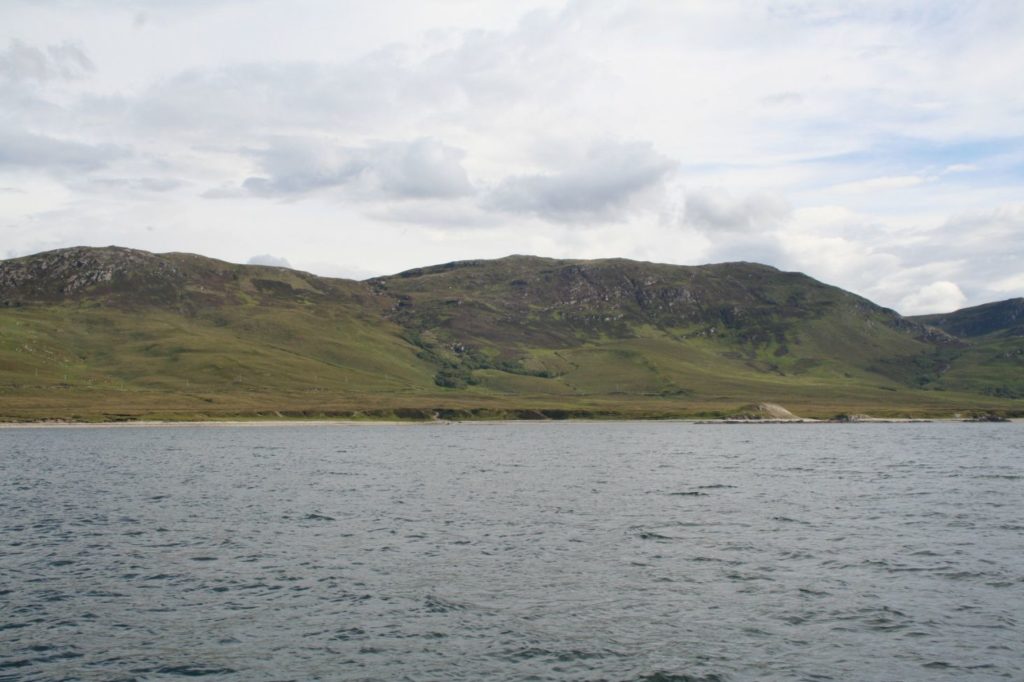It was an option to stay in Scrabster but the sea forecasts and weather looked like they were going to get a bit challenging over the next few days and our mission was to get round Cape Wrath to Kinlochbervie on the west coast. If we were going to be held up for a few days at least we would get that particular monkey off of our back.

We charged out of the squarish bay in which Scrabster and Thurso occupy each corner and set course for Cape Wrath some 50 miles distant, the sea was glassy and the sun was shining. Nigel commented that it was the best sea state that we had experienced since leaving Gosport………
Far off we could sea some cloud activity, as we got further down the track there were ominous darker clouds and banks of showers on the horizon. The sea state gradually built up but was still mostly in a favourable i.e. following direction.Then within another 30 minutes or so bigger white caps started to form and the wind and resultant waves swung round to hit us directly on the bow of the boat. We had got sufficiently far enough along the coast for the decision to turn back to Scrabster being less favourable than pulling into Loch Eriboll in case of need, in the meantime we slowed down to displacement speed (half of what we had been achieving) and plugged on.


With each dark cloud squall the waves seemed to get bigger with shorter distances between them, so having successfully climbed to the top of one we ploughed into the next one more or less immediately with the spray going over the wheelhouse. The boat was coping magnificently but I couldn’t see us putting up with this for very much longer, it was decided to pull into Loch Eriboll a few miles distant but with guaranteed shelter from this unpredicted stormy weather. We headed for the western headland at the entrance to Loch Eriboll hoping for increasing protection from the sea state as we gradually took the waves increasing on the beam of the boat, this seemed to take ages but little by little the waves got smaller and smaller until we were safely in the sheltered water of Loch Eriboll itself.

Loch Eriboll is almost 10 miles long and has been used as a port of refuge between the Pentland Firth and Cape Wrath for no doubt centuries. The Royal Navy used it extensively during World War Two and it was fondly referred to as Loch ‘Orrible by the British service men stationed there. It is of course spectacularly beautiful but literally has nothing to offer leisure boaters other than peaceful anchorages and said spectacular scenery. I was at least pleased that I had made my trip to Tescos to stock up but I definitely didn’t want to be trapped there for more than a night. There was no signal for mobile phones and therefore the feeling of being cut off form the world other than the trusty VHF for weather forecasts was complete.
We counted three sailing boats (always sailing boats) anchored in the most favourable spots and chose a spot ourselves to anchor and consider our next move. Having successfully dropped the hook it was noticed that what we thought was a local’s mooring buoy was in fact a fisherman’s pot marker with a very long rope attached to another very small float. the anchor was retrieved and we looked for another spot, in fact going up to the very end of the loch. In the pilot guides it comforts you with the knowledge that the weather can be very unpredictable here as katabatic winds funnel down from the mountains and or build up momentum through the immense valleys leading to the anchorage. That’ll be great for a trouble free night then!
We head back down the loch towards the entrance looking for other more favourable anchorages, we notice that the wind has dropped. We are unsure as to whether this is localised or general. We carry on further towards the entrance to the loch and I make a mental note of a couple of places where we might get a good nights sleep. The wind is still on the gentler side as we we chat about poking our nose back out into ocean to see what is actually going on out there, if it’s still rough then we’ll head back in but if it has reduced to a manageable level then we’ll continue our passage around Cape Wrath to Kinlochbervie some 30 miles distant.
This whole process had taken probably 90 minutes or so, and when we finally exited Loch Eriboll the sea state had reduced dramatically and the stormy weather had passed away to the east. We continued on to Cape Wrath which actually looks as severe as it’s named, giving it a wide berth to avoid the worst of the various races to be found there ( Nigel felt that I should have taken an even wider berth) and to head south for the first time since we had left Gosport Marina. I had been worried about what sea state we would be met with having rounded this corner but it was fine. One hour later we were alongside in KInlochbervie, a fishing port with space for eight visitors on a floating pontoon, with electricity and water and some spectacular views all of its own.

There was a hotel/pub/restaurant, a Spar and diesel what more could a motorboater want? The restaurant was a least a mile away up a big Scottish hill , time to break out the electric scooters. The boat was hosed down and off we went to celebrate our successful rounding of the very top of the island of Great Britain.

We were full of a sense of achievement and eventually full of numerous beers,wine and other rum based drinks.